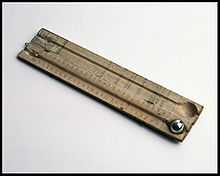Timeline of temperature and pressure measurement technology
Timeline of temperature and pressure measurement technology. A history of temperature measurement and pressure measurement technology.
Timeline
1500s
- 1592–1593 — Galileo Galilei builds a device showing variation of hotness known as the thermoscope using the contraction of air to draw water up a tube.[1]
1600s
- 1612 — Santorio Sanctorius puts thermometer to medical use
- 1617 — Giuseppe Biancani published the first clear diagram of a thermoscope
- 1624 — The word thermometer (in its French form) first appeared in La Récréation Mathématique by Jean Leurechon, who describes one with a scale of 8 degrees.[2]
- 1629 — Joseph Solomon Delmedigo describes in a book an accurate sealed-glass thermometer which uses brandy
- 1638 — Robert Fludd the first thermoscope showing a scale and thus constituting a thermometer.
- 1643 — Evangelista Torricelli invents the mercury barometer
- 1654 — Ferdinando II de' Medici, Grand Duke of Tuscany, made sealed tubes part filled with alcohol, with a bulb and stem, the first modern-style thermometer, depending on the expansion of a liquid, and independent of air pressure[2]
- 1661 — Christiaan Huygens built the U-tube.[3]
- 1695 — Guillaume Amontons improved the thermometer

Christin's thermometer (1743).
1700s
- 1701 — Newton publishes a method of determining the melting points of certain metals and introduces a scale which had 0 degrees representing the freezing point of water and 12 degrees the human body temperature.
- 1701 — Ole Christensen Røemer made one of the first practical thermometers. As a temperature indicator it used red wine. (Rømer scale), The temperature scale used for his thermometer had 0 representing the temperature of a salt and ice mixture (at about 259 s).
- 1709 — Daniel Gabriel Fahrenheit constructed an alcohol thermometer e
- 1714 — Daniel Gabriel Fahrenheit invents the mercury-in-glass thermometer x
- 1731 — René Antoine Ferchault de Réaumur the Réaumur scale, On this scale 0 represented the freezing point of water (273.15 K) and 80 represented the boiling point (373.15 K).
- 1738 — Daniel Bernoulli asserted in Hydrodynamica the principle that as the speed of a moving fluid increases, the pressure within the fluid decreases. (Kinetic theory)
- 1742 — Anders Celsius created an inverted centigrade or Celsius temperature scale in which 100 represented the freezing point (273.15 K) and 0 represented the boiling point (373.15 K).
- 1743 — Jean-Pierre Christin had worked independently of Celsius and developed a scale where zero represented the melting point of ice (273.15 K) and 100 represented the boiling point (373.15 K).
- 1744 — Carl Linnaeus suggested reversing the temperature scale of Anders Celsius so that 0 represented the freezing point of water (273.15 K) and 100 represented the boiling point (373.15 K).
- 1782 — James Six invents the Maximum minimum thermometer
1800s
- 1821 — Thomas Johann Seebeck invents the thermocouple
- 1844 — Lucien Vidi invents the Barograph, an aneroid barometer[4]
- 1848 — Lord Kelvin (William Thomson) – Kelvin scale, in his paper, On an Absolute Thermometric Scale
- 1849 — Eugene Bourdon – Bourdon_gauge (manometer)
- 1849 — Henri Victor Regnault – Hypsometer
- 1864 — Henri Becquerel suggests an optical pyrometer
- 1866 — Thomas Clifford Allbutt invented a clinical thermometer that produced a body temperature reading in five minutes as opposed to twenty.[5]
- 1871 — William Siemens describes the Resistance thermometer at the Bakerian Lecture
- 1874 — Herbert McLeod invents the McLeod gauge
- 1885 — Calender-Van Duesen invented the platinum resistance temperature device
- 1887 — Richard Assmann invents the psychrometer (Wet and Dry Bulb Thermometers)
- 1892 — Henri-Louis Le Châtelier builds the first optical pyrometer
- 1896 — Samuel Siegfried Karl Ritter von Basch introduced the Sphygmomanometer to measure blood pressure
1900s
- 1906 — Marcello Pirani – Pirani gauge ( to measure pressures in vacuum systems)
- 1924 — Irving Langmuir – Langmuir probe (to measure plasma parameters)
- 1930 — Samuel Ruben invented the thermistor
See also
References
- ↑ Vincenzo Viviani (1654) Racconto istorico della vita del Sig.r Galileo Galilei
- ↑ 2.0 2.1 R. P. Benedict (1984) Fundamentals of Temperature, Pressure, and Flow Measurements, 3rd ed., ISBN 0-471-89383-8, p. 4
- ↑ Attila Imre, W. Alexander van Hook (1998). "Liquid–liquid equilibria in polymer solutions at negative pressure". Chemical Society Reviews 27 (2): 117. doi:10.1039/A827117Z.
- ↑ Louis Figuier; Émile Gautier (1867). L'Année scientifique et industrielle. L. Hachette et cie. pp. 485–486.
- ↑ Sir Thomas Clifford Allbutt, Encyclopædia Britannica